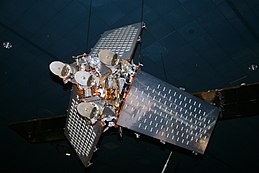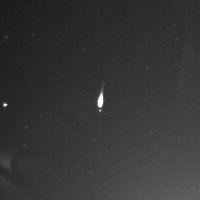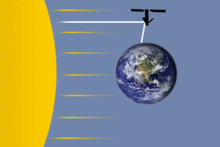
A communications satellite is an artificial satellite that relays and amplifies radio telecommunication signals via a transponder; it creates a communication channel between a source transmitter and a receiver at different locations on Earth. Communications satellites are used for television, telephone, radio, internet, and military applications. Many communications satellites are in geostationary orbit 22,236 miles (35,785 km) above the equator, so that the satellite appears stationary at the same point in the sky; therefore the satellite dish antennas of ground stations can be aimed permanently at that spot and do not have to move to track the satellite. Others form satellite constellations in low Earth orbit, where antennas on the ground have to follow the position of the satellites and switch between satellites frequently.
Iridium Communications Inc. is a publicly traded American company headquartered in McLean, Virginia, United States. Iridium operates the Iridium satellite constellation, a system of 75 satellites: 66 are active satellites and the remaining nine function as in-orbit spares. Iridium Satellites are used for worldwide voice and data communication from handheld satellite phones, satellite messenger communication devices and integrated transceivers, as well as for two-way satellite messaging service from supported conventional mobile phones. The nearly polar orbit and communication between satellites via inter-satellite links provide global service availability.

A satellite constellation is a group of artificial satellites working together as a system. Unlike a single satellite, a constellation can provide permanent global or near-global coverage, such that at any time everywhere on Earth at least one satellite is visible. Satellites are typically placed in sets of complementary orbital planes and connect to globally distributed ground stations. They may also use inter-satellite communication.

Teledesic was a company founded in the 1990s to build a commercial broadband satellite internet constellation. Using low-Earth-orbiting satellites small antennas could be used to provide uplinks of as much as 100 Mbit/s and downlinks of up to 720 Mbit/s. The original 1994 proposal was extremely ambitious, costing over 9 billion USD and originally planning 840 active satellites with in-orbit spares at an altitude of 700 km. In 1997, the plan was scaled back to 288 active satellites at 1400 km. Teledesic Corporation changed its name to Teledesic, LLC by pro forma assignment of its license, granted on 26 January 1998.

Skynet is a family of military communications satellites, now operated by Babcock International on behalf of the United Kingdom's Ministry of Defence (MoD). They provide strategic and tactical communication services to the branches of the British Armed Forces, the British intelligence agencies, some UK government departments and agencies, and to allied governments. Since 2015 when Skynet coverage was extended eastward, and in conjunction with an Anik G1 satellite module over America, Skynet offers near global coverage.
Globalstar, Inc. is an American satellite communications company that operates a low Earth orbit (LEO) satellite constellation for satellite phone, low-speed data communications and earth observations. The Globalstar second-generation constellation consists of 25 low Earth orbiting (LEO) satellites.
The Ka band is a portion of the microwave part of the electromagnetic spectrum defined as frequencies in the range 26.5–40 gigahertz (GHz), i.e. wavelengths from slightly over one centimeter down to 7.5 millimeters. The band is called Ka, short for "K-above" because it is the upper part of the original NATO K band, which was split into three bands because of the presence of the atmospheric water vapor resonance peak at 22.24 GHz (1.35 cm), which made the center unusable for long range transmission. The 30/20 GHz band is used in communications satellite uplinks in either the 27.5 GHz or 31 GHz bands, and in high-resolution, close-range targeting radars aboard military airplanes. Some frequencies in this radio band are used for vehicle speed detection by law enforcement. The Kepler Mission used this frequency range to downlink the scientific data collected by the space telescope.

A satellite telephone, satellite phone or satphone is a type of mobile phone that connects to other phones or the telephone network by radio link through satellites orbiting the Earth instead of terrestrial cell sites, as cellphones do. Therefore, they can work in most geographic locations on the Earth's surface, as long as open sky and the line-of-sight between the phone and the satellite are provided. Depending on the architecture of a particular system, coverage may include the entire Earth or only specific regions. Satellite phones provide similar functionality to terrestrial mobile telephones; voice calling, text messaging, and low-bandwidth Internet access are supported through most systems. The advantage of a satellite phone is that it can be used in such regions where local terrestrial communication infrastructures, such as landline and cellular networks, are not available.
Orbital Sciences Corporation was an American company specializing in the design, manufacture, and launch of small- and medium- class space and launch vehicle systems for commercial, military and other government customers. In 2014, Orbital merged with Alliant Techsystems to create a new company called Orbital ATK, Inc., which in turn was purchased by Northrop Grumman in 2018. The remnants of the former Orbital Sciences Corporation became a subsidiary of Northrop Grumman, known as Northrop Grumman Space Systems.
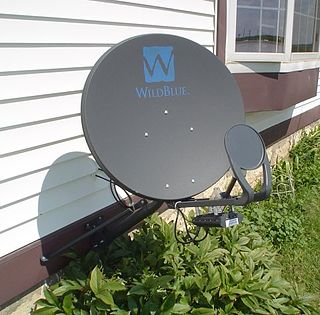
Satellite Internet access is Internet access provided through communication satellites; if it can sustain high speeds, it is termed satellite broadband. Modern consumer grade satellite Internet service is typically provided to individual users through geostationary satellites that can offer relatively high data speeds, with newer satellites using the Ku band to achieve downstream data speeds up to 506 Mbit/s. In addition, new satellite internet constellations are being developed in low-earth orbit to enable low-latency internet access from space.

Satellite flare, also known as satellite glint, is a satellite pass visible to the naked eye as a brief, bright "flare". It is caused by the reflection toward the Earth below of sunlight incident on satellite surfaces such as solar panels and antennas. Streaks from satellite flare are a form of light pollution that can negatively affect ground-based astronomy, stargazing, and indigenous people.
ORBCOMM is an American company that offers industrial internet and machine to machine (M2M) communications hardware, software and services designed to track, monitor, and control fixed and mobile assets in markets including transportation, heavy equipment, maritime, oil and gas, utilities and government. The company provides hardware devices, modems, web applications, and data services delivered over multiple satellite and cellular networks.

Inmarsat is a British satellite telecommunications company, offering global mobile services. It provides telephone and data services to users worldwide, via portable or mobile terminals which communicate with ground stations through fifteen geostationary telecommunications satellites.

Iridium 33 was a communications satellite launched by Russia for Iridium Communications. It was launched into low Earth orbit from Site 81/23 at the Baikonur Cosmodrome at 01:36 UTC on 14 September 1997, by a Proton-K rocket with a Block DM2 upper stage. The launch was arranged by International Launch Services (ILS). It was operated in Plane 3 of the Iridium satellite constellation, with an ascending node of 230.9°.

O3b is a satellite constellation in Medium Earth orbit (MEO) owned and operated by SES, and designed to provide low-latency broadband connectivity to remote locations for mobile network operators and internet service providers, maritime, aviation, and government and defence. It is often referred to as O3b MEO to distinguish these satellites from SES's forthcoming O3b mPOWER constellation.
Technology Education Satellite (TechEdSat) is a successful nano-sat flight series conducted from the NASA Ames Research Center in collaboration with numerous universities. While one of the principal aims has been to introduce young professionals and university students to the practical realm of developing space flight hardware, considerable innovations have been introduced. In addition, this evolving flight platform has tested concepts for Low Earth Orbit (LEO) sample return, as well as planetary nano-sat class mission concepts.
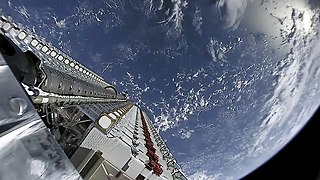
Starlink is a satellite internet constellation operated by Starlink Services, LLC, a wholly-owned subsidiary of American aerospace company SpaceX, providing coverage to over 75 countries. It also aims to provide global mobile broadband.

Eutelsat OneWeb is a subsidiary of Eutelsat Group providing broadband satellite Internet services in low Earth orbit (LEO). The company is headquartered in London, and has offices in Virginia, US and a satellite manufacturing facility in Florida – Airbus OneWeb Satellites – that is a joint venture with Airbus Defence and Space.
A satellite internet constellation is a constellation of artificial satellites providing satellite internet service. In particular, the term has come to refer to a new generation of very large constellations orbiting in low Earth orbit (LEO) to provide low-latency, high bandwidth (broadband) internet service.
The Celestri Multimedia LEO System was a planned Low Earth orbit (LEO) satellite constellation, which was intended to offer global, low-latency broadband Internet services via Ka-band radio links. It was planned by Motorola circa 1997-1998 as one of the earliest "Internet in the sky" constellations, and as a successor to the company's Iridium satellite constellation, but never built or launched.
